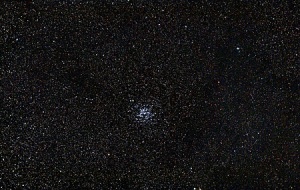Messier 11: Difference between revisions
(→Scutum) |
(→Scutum) |
||
| Line 5: | Line 5: | ||
==Scutum== | ==Scutum== | ||
Scutum lies in a bright area of the Milky Way and is distinctive despite its small size. Its brightest stars are of only fourth magnitude, and none are named, but the constellation contains a celebrated cluster of stars popularly known as the Wild Duck cluster because its fan-shape resembles a flight of ducks. | |||
In the Chinese constellation system, five or six stars of northern Scutum, including Alpha, Beta and Eta Scuti, were grouped with others in Aquila to form a nine-star constellation called Tianbian. This represented a team of trade officials overseeing the organization and operation of markets. The area of sky to the west, incorporating much of [[Ophiuchus]] and Serpens plus southern Hercules, was visualized as a marketplace. <ref>[http://www.ianridpath.com/startales/scutum.htm Scutum]</ref> | In the Chinese constellation system, five or six stars of northern Scutum, including Alpha, Beta and Eta Scuti, were grouped with others in Aquila to form a nine-star constellation called Tianbian. This represented a team of trade officials overseeing the organization and operation of markets. The area of sky to the west, incorporating much of [[Ophiuchus]] and Serpens plus southern Hercules, was visualized as a marketplace. <ref>[http://www.ianridpath.com/startales/scutum.htm Scutum]</ref> | ||
==Etymology== | ==Etymology== | ||
Revision as of 00:49, 2 March 2015
Messier 11 is The Wild Duck Cluster (also known as Messier 11, or NGC 6705) is an open cluster in the constellation Scutum. It was discovered by Gottfried Kirch in 1681. Charles Messier included it in his catalogue in 1764. The Wild Duck Cluster is one of the richest and most compact of the known open clusters, containing about 2900 stars. Its age has been estimated to about 220 million years. Its name derives from the brighter stars forming a triangle which could resemble a flying flock of ducks. [1]
Scutum
Scutum lies in a bright area of the Milky Way and is distinctive despite its small size. Its brightest stars are of only fourth magnitude, and none are named, but the constellation contains a celebrated cluster of stars popularly known as the Wild Duck cluster because its fan-shape resembles a flight of ducks.
In the Chinese constellation system, five or six stars of northern Scutum, including Alpha, Beta and Eta Scuti, were grouped with others in Aquila to form a nine-star constellation called Tianbian. This represented a team of trade officials overseeing the organization and operation of markets. The area of sky to the west, incorporating much of Ophiuchus and Serpens plus southern Hercules, was visualized as a marketplace. [2]
Etymology
Scutum is the Latin word for shield, although it has in modern times come to be specifically associated with the rectangular, semi-cylindrical body shield carried by Roman legionaries. [3]
Session References
HGS Sessions - Parallel Earth 2/12/2015
References
Found in HGS Manual on Page 108


